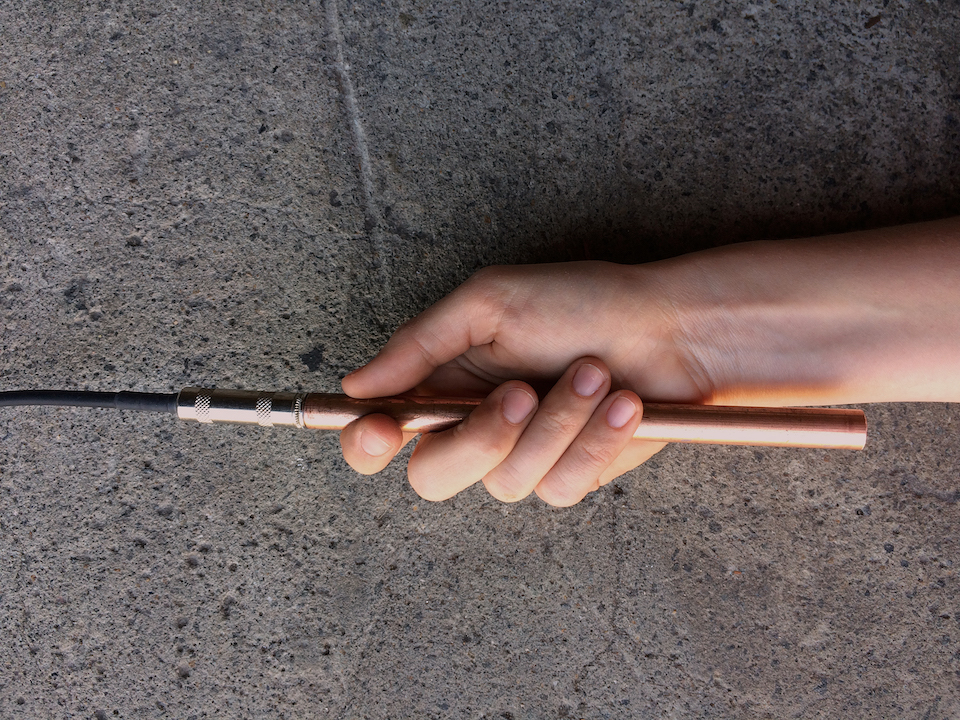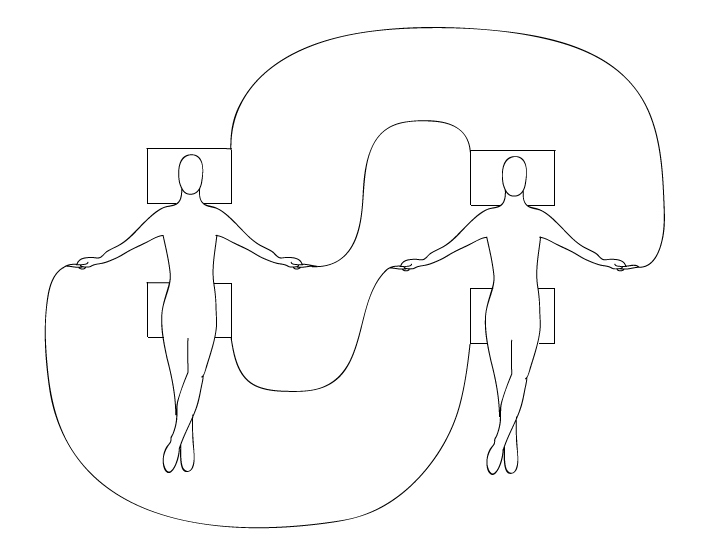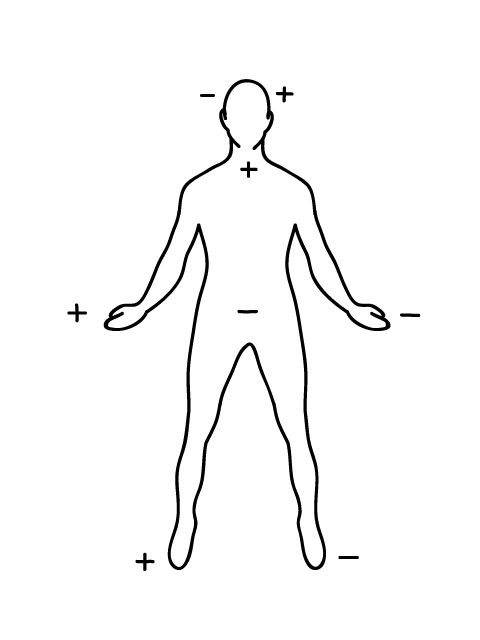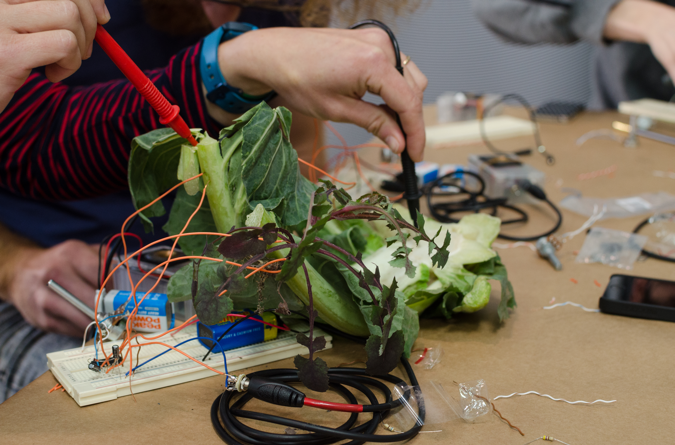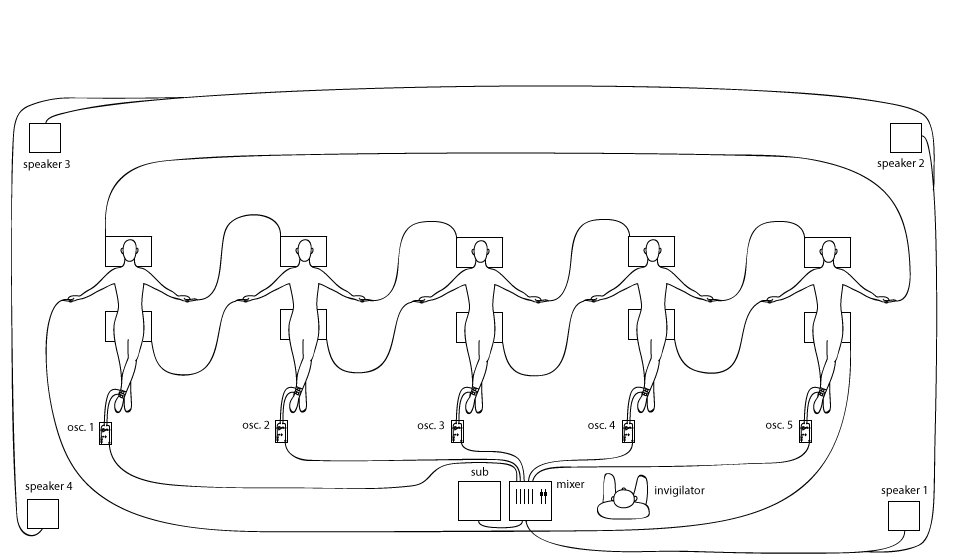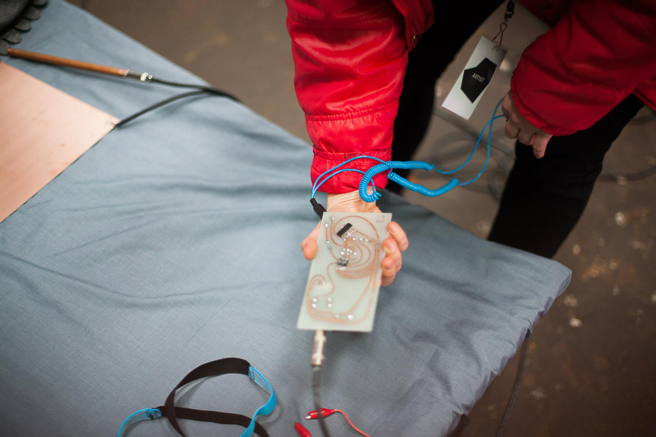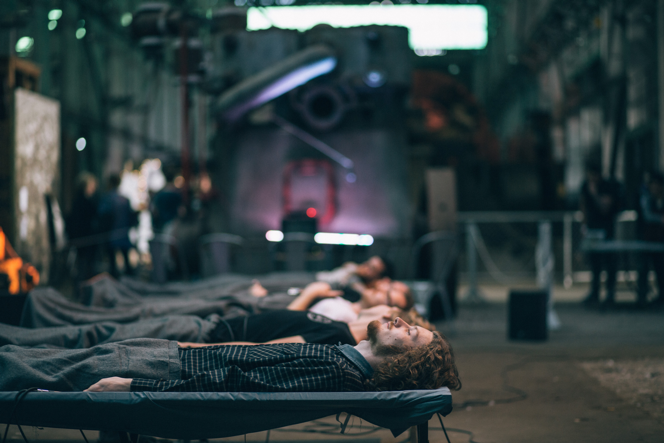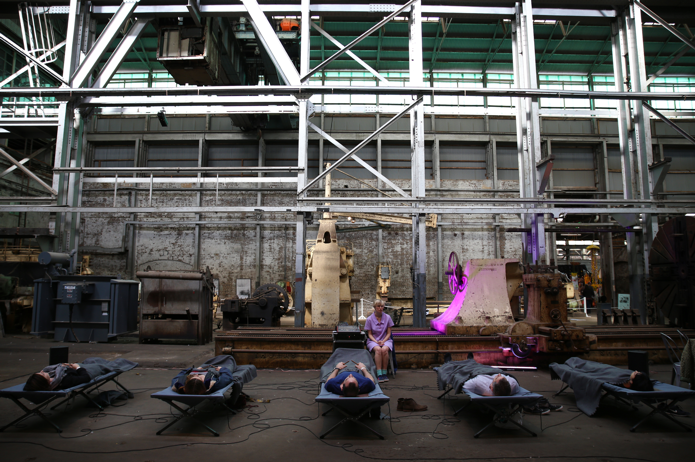Bodies and Energy, Circuits and Sound: Rethinking and Listening to Leon Ernest Eeman’s Relaxation Circuit with a Bio-synthesizer
Pia van Gelder
Leon Ernest Eeman was born in Belgium in 1889 and served in the First World War between 1915 and 1918, which left him with injuries from a plane crash, dysentery and malaria. During his lengthy recovery in hospital, Eeman conceived of a healing technique that utilized what he called “human radiations” or electric currents present in the body, what we now know as bioelectricity. After nearly two years in care, Eeman moved to London and embarked on a lengthy period of research and development. He published a series of books, including Self and Superhuman (1929) that discussed his research on consciousness; an English translation of the French painter and writer Pierre-Emile Cornillier’s The Prediction of the Future, A New Experimental Theory (1947); and How Do You Sleep? (1936), which introduced some of Eeman’s experiments with bioelectricity and other exercises for developing healthy sleep habits.[1] Finally, in 1947, Eeman completed Cooperative Healing, The Curative Properties of Human Radiations, which documented his research with approximately one hundred case studies testing both his Relaxation Circuit and Tension Circuit. Although Eeman’s work is characteristic of a movement in the healing arts, which sought to harness these subtle electric currents, outside of his writing, information on Eeman is scant. Other examples of these practices have been discussed recently as valuable evidence regarding how we have come to understand our corporeal connection with technology and energy. For that reason I decided to appropriate Eeman’s Relaxation Circuit in the form of a participatory installation involving a bio-synthesizer. Here I will recount my appropriation of his work after giving some historical context to his original study.
Dancing Frog’s Legs, Driving Forces, Auditory Nerves
After six years of research into the mechanisms of hearing in humans, quadrupeds and birds, the Italian physicist Luigi Galvani chose to pursue his experiments with electrophysiology. This led to his famous demonstration in the mid 1780s, starring a reanimated set of frog’s legs plugged into a leyden jar.[2] Galvani proposed that animal electricity was what reanimated these lifeless lower limbs of a frog. This served as further evidence fueling a fiery debate that had ignited around vitalism in the sciences in which discoveries in physical science and physiology were challenging established ideas of what life is.[3] It didn’t take long for these probes to find their way to humans, and Charles Kite was able to design the defibrillator. Galvani also went on to probe humans with much weaker currents in an early form of direct cranial electronic stimulation. Numerous instruments bore Galvani’s name, such as the galvanoscope, designed to detect electrical current using a frog’s leg, and the later galvanometer, which gave scientists the ability to measure electrical current.
In the 1840s, physician and physicist Hermann von Helmholtz connected a galvanometer to a frog’s leg to measure the speed that a signal travels through nerve fiber. This experiment preceded his work on The Conservation of Force (1847), which continued to poke at vitalist arguments. What would follow were questions about how different forms of sensory stimuli may vary reactions. This work, as it pertained to hearing, culminated in Helmholtz’s On the Sensations of Tone (1863), which presented the body’s anatomically specific responses to the physical vibrations of sound, from the cochlea to the nervous system. In his popular distinctions between the physical phenomena of music and noise, along with his detailed descriptions of how sound materialized in the body energetically, through our complex nerve network, Helmholtz’s work made noise matter more.
The transformation of people’s audible environments as a result of the industrial revolution and urbanization is a story deeply connected to noise. The impact of noise on the body, specifically the nervous system, is an important historical relationship that has been brought to the forefront by recent scholars, including Karin Bijsterveld in her work on Mechanical Sound and “the public problems of noise” (2008) and James Mansell’s The Age of Noise in Britain (2017), which provides a useful history of the medicalization of noise specific to Britain in the twentieth century. Both of these works highlight the connections made between noise and the nerves, demonstrating how noise was understood to materialize in the body. Bijsterveld points out that “[w]hile industrial noise emission had largely been handled as threatening property and institutions, early-twentieth-century street noise was widely understood to endanger the minds and bodies of city dwellers” (Bijsterveld 2008: 92). Mansell emphasizes that people were marked more by unwanted noise than other sensory stimuli and that, “cumulatively, the effect of its enveloping sonic bombardment was thought to drain energy and perpetually overstimulate the body’s nerves” (Mansell 2017: 4). From the body to the city, these changing spaces of habitation were what Leon Ernest Eeman was responding to when developing his Cooperative Healing.
Eeman’s conception of space and the body was fluidic and energetic, facilitated by the concept of the ether, a material that was still commonly believed to fill space well after the introduction of Einstein’s theory of relativity in 1905. Like so many others, to Eeman, the ether existed as a material permeated by vibrations, magnetism, electricity, and psychic suggestion.[4] Eeman found the ether useful in explaining a number of phenomena, namely “ether vibrations” and “ether radiations,” which he suggested were the frequencies for telepathic transmission produced by nerve cells.[5] The German physician Franz Anton Mesmer proposed that he could manipulate the ether and energetic fluids of the body with what he called animal magnetism, using his hands and his eyes. He attracted a popular following well into the nineteenth century and was influential in the development of hypnotism.[6] Mesmerists offered a cure for the energy depletion and “wasting” that seemed to come from modern lifestyles, which they proposed could be redistributed from mesmerist to patient. Although Mesmerism was scientifically criticized, it successfully captivated the popular mind in a way that prepared people for the electric medicine that would follow.
In the 1840s, studies of the nervous system prompted the well-known chemist and industrialist Carl von Reichenbach to investigate what he called “Odic” force, which became a grounding theory for Eeman’s cooperative healing (Eeman 1947: 317, 379). This was a vital energy or life force, which he claimed to consist of an energy akin to electricity, which radiated from living things and materials. In line with a more scientific understanding of energy, as the title of Reichenbach’s study suggested, Researches on Magnetism, Electricity, Heat, Light, Crystallization, And Chemical Attraction, In Their Relations to The Vital Force (1850) proposed that these forces had negative and positive polarities, which could be mapped on the human body from the head to the genitals and from the left to the right. These poles could be studied visually by a person “sensitive” to these forces isolated in total darkness with the subject. Odic force was presented as a colored “aura” which had breezy or air-like qualities that surrounded the subject, changing colors and temperatures at the respective poles. Sensitive observers of Odic force were posited by Reichenbach to be in a state of hypnotic or mesmeric trance.[7] Reichenbach’s scientific focus did not discourage people from making cultural and spiritual connections with Odic force, such as relating it to the Chinese concept of “qi.” Additionally, Reichenbach’s work includes references to alchemy, including his choice to name the force after Odin, the god associated with mercury in Scandinavian mythology.[8]
The domestication of electricity in the late nineteenth and early twentieth century made this bodily exploration of electric current more available to the home consumer. Door to door salesmen offered electric belts that promised to increase male vitality. In London’s Pall Mall shoppers could purchase electric corsets, which were said to promote better health and a more attractive physique. These applications had wider ramifications: Carolyn Thomas De La Peña discusses the emergence of these “electrotherapies” and other technologies specific to the gendered body within the United States. She says that “directly transferring energy” from these technologies “to internal circulatory and muscular systems, mechanical, electric and radioactive technologies promised to bring the body along on the road to rapid modernisation” (Thomas De La Peña 2003: 3). Similarly, John L. Greenway discusses the history specific to electric medicine and connections to so-called “nervous disease,” with some particular attention paid to James Graham’s Temple of Health, which was established in London in 1779. Graham offered to treat people with “electrical aether,” using electrical apparatuses at his popular health houses. His work was an important local precedent to Eeman’s, bringing electric medicine into the public vernacular over a century before Eeman came to town (Greenway 1987: 46-73). Applied at the correct current, electricity appeared to offer a way to rectify social behavior, from emotional instability to sexual vitality. Taking social discipline [and legal punishment] to the extreme, it is even a way of administering the death penalty, which has been in use since 1890 in the United States.[9]
In Modernism, Technology and the Body, Tim Armstrong explains how during this period, the body was widely conceived of as “the machine in which the self lived; the site of an animal nature which required conscious regulation” (Armstrong 1998: 2). Further discourses (which would be echoed in Eeman’s later writing) described the body as an electronic circuit with “energy flows” and “resistors,” positioning the body as an electric instrument that could be fine-tuned like a radio. Nineteenth-century city dwellers were commonly struck down by their new fast-paced life with ill health that manifested itself both physiologically and psychologically, most often as fatigue and exhaustion (with a list of other possible symptoms). This sickness was summarized by a diagnosis of “nervousness,” “nervous disease,” or “neurasthenia,” and its signature depletion of energy was often explained as a reaction to the innovations of modern life, transport, telecommunications, high speed machinery, and noise. In response, electrotherapy was offered as a panacea.
Cooperative Healing
The historical relationship between nerves, noise and industrialization are key to exploring Eeman’s work. It is also essential to understand the divergence in electric medicine between methods adopted by the medical community and those that were less accepted due to what the community viewed as a lack of empirical evidence. Some of these alternative therapies made use of minute, sometimes imperceptible, amounts of electric current, as well as methods of application that did not involve direct contact. Two such practices, radionics and dowsing, were informative for Eeman’s work. Dowsing is a divination practice used for searching for anything. The query may be an answer to a question, a material, including a resource like underground water or oil, or detecting energy fields in the body.[10] Radionics is a therapy that made use of electrical devices that are proposed to receive and transmit electromagnetically in order to diagnose and heal a multitude of ailments. For radionics, the popularity of radio and its contagious metaphor had generated analogic associations that implied that the body could be tuned into and, in turn, that the mind was an instrument capable of sending and receiving electromagnetic signals. Radionics is most closely associated with Dr. Albert Abrams and his famous instrument, the oscilloclast.[11] Eeman presented his research to the Congress of Radionics and the British Society of Dowsers and referred to the work of Abrams and other similar electrotherapists in his book.[12]
What set Eeman’s work apart from these other electrotherapists was his utilization of the passive circuit. Instead of connecting his subjects to an electric current generated from an external power source, like a battery, he worked on the basis that the body was capable of generating its own charge. Eeman proposed that the body is like a battery, with a cathode that generates negative charge and an anode generating positive charge. In his own way, he carried on from Reichenbach’s Odic forces, explaining that when the body is connected to itself or to other bodies using electrically-conductive wires and plates, in an arrangement that corresponds with these said polarities, the “bodies behave as though using an electro-magnetic analogy – they were bi-polar.” To make use of this charge of “vital energy,” bodies were connected by “three axes: head to feet, right side to left, and back to front, and their detailed bi-polarities follow the known nervous tracts.” These directional forces could be set up to flow in one direction, as a Relaxation Circuit, or in the opposite direction, as a Tension Circuit. Eeman proposed that his Relaxation Circuit promotes “relaxation of voluntary muscles and stimulates functional activity. It fosters sleep, recovery from fatigue and disease, capacity for work and health in general. The tension circuit reverses these more or less. Both circuits affect not only organic but also nervous and mental health” (Eeman 1947: 17).
When looking at Eeman’s diagram of the Relaxation Circuit, the symbolism of the act of lying together in parallel, connected by wires in something akin to an electrical circuit, makes a provocative gesture of communion, a proposal about the power of collectivity, the potential of joined bodies. Not explicit in this diagrammatic proposition are the continued attacks from the scientific and medical community and the subsequent categorization of such work as pseudo-science and quackery that many of these associated practitioners endured. On further investigation, the contention around the legitimacy of these practices cannot be disregarded either. Legal cases brought against electrotherapists by medical associations were sometimes the incident that served to propel these practitioners into public attention. Albert Abrams was charged with fraud by the American Medical Association in 1924. Although his trial was never resolved, scientific journals published several reports, which cast his practices into doubt.[13] The Austrian psychoanalyst Wilhelm Reich, known for his theories on orgone energy, was jailed for contempt in 1956. My research does not aim to interrogate these questions of legitimacy or the scientific authenticity of their claims; instead, I’m interested in exploring what these case studies offer in terms of their cultural, philosophical, and social significance in relation to our understanding of energy. The Orgone Accumulator, the Oscilloclast, and the Relaxation Circuit make intriguing propositions about energy, the body, and technology. These technologies all explore the possible implementation of the body’s own electric charge. However, Eeman’s Relaxation Circuit is unique in considering the body to be self-sufficient, countering the culture of mainstream medicine at that time. By providing schematics for his devices in his literature, Eeman demonstrated how his techniques could be implemented with simple materials, unlike practitioners such as Abrams and Reich, who offered their machines at a price and kept their designs secret. Here, the underlying politics and culture of energy are played out differently, with Eeman appearing to suggest that energy can be harnessed freely and used for individual or collective gain without government or corporate regulation. Further, his circuits appear prescient of later technological concepts, including cybernetics, network theory, and biofeedback.[14] It was my intention to participate in and reflect on this particular historical discourse by appropriating Eeman’s Relaxation Circuit.
Relaxation Circuit and the Senses
A number of case studies in electric medicine discuss the possibilities of correspondences between electricity and other phenomena described in terms of frequency, such as color and sound. Examples include both Abrams, who installed a speaker into his Oscilloclast, and, before him, “Dr.” James Graham, who used music in his health houses. Whether Eeman was aware of any such direct precursors is unclear. However, Eeman engages in this topic at several points throughout Cooperative Healing, suggesting that correspondences between frequencies in their varied manifestations could be incorporated within his therapies.[15] Discussing what appeared to him to be incongruences between the frequencies of light and sound and their influence on relaxation and breathing in his findings, he pontificated on another medium, other than the ether, which was still understood as a conduit for thoughts or suggestions, through which this emotional or “psychic” information might travel. In his preliminary notes, Eeman suggests that:
the human organism can offer specific reactions only to specific agents and that since many of its reactions are known to be caused by ‘frequencies’, such as those of light, sound and other rays, most if not all of the new reactions which I have observed, may in time be shown to be related to frequencies and ‘specific frequencies’ whether or not resonant. (Eeman 1947: 15)
In a chapter devoted to the connections between his technique and conscious thought, Eeman goes further to discuss the impact of other sensory media, including light and sound, saying they “do not only stimulate the special sense organs of the body; they also cause the organism as a whole to react to them in a manner” that is “beneficial or detrimental to health.” He goes on to recall experiments with color therapy instituted in hospitals in 1918 for the treatment of “nerve-shattered” soldiers (Eeman 1947: 131). Eeman’s suggestion that sensory media may be included in his circuits is where I took the initiative to expand his arrangement to include sound.
Bio-Synthesiser
For my adaptation of the Relaxation Circuit, I was interested in exploring the energetic correspondences Eeman proposes in his work by incorporating a bio-synthesizer. My practice has often involved electronics and circuit building as a way of creating visual and sonic work, which has recently explored bio-synthesis with the use of electroencephalography (which measures the electronic frequencies generated by the brain) and galvanic skin conduction (which involves the electrical conductivity of skin) in many projects.[16] In 2013 I designed, in collaboration with Indonesian artist and bio-hacker Andreas Siagian and Brisbane artist Michael Candy, an environmentally-sensitive synthesizer which reacted to weather and soil conduction, which we installed on the second base camp of Mount Merapi, an active volcano, as a part of the Instrument Builders Project in Yogyakarta, Indonesia. The work was called Mountain Operated Synthesiser, and the circuit itself was called the bio-synthesiser. Subsequently, I explored variations of this circuit to include electrodes for body contacts, among other inputs. Another example, Biosc, a project I developed in Yogyakarta a year later with seventeen other artists and scientists for Hackterialab 2014 also involved bio-synthesis. In this work we attempted to detect electrical variations of micro-current induced by daphnia (tiny freshwater crustaceans) moving through water as well as ants and worms in soil.[17] Since then, I have facilitated a number of electronics workshops that have introduced principles of bio-synthesis in a hands-on context as well as incorporating these circuits into live performances.
Relaxation Circuit (2015) was to be arranged as a participatory installation where people could choose to take part in the circuit. The size of the circuit (the number of participants) was organized in relation to the dimensions of the space the work was to be presented in. For this presentation, I developed two separate circuits, firstly, the reworking of Eeman’s Relaxation Circuit, built for up to five participants, using copper plates, insulated cable, and copper rods. The second circuit was the bio-synthesizer, which was designed to sonify Eeman’s “human radiations” (see illustration above). This was a low power, polyphonic square wave synthesizer made of five identical oscillators, which were designed using the Hex Schmitt Trigger IC (40106). This simple square wave Hex oscillator was chosen because its low power requirements made it safe for direct physical interaction and did not require additional intervening components (no computers or microprocessors) for digital processing.[18] Each oscillator was designed to be modulated by the conductivity of the participant’s skin using electrodes that were connected to the participant’s leg. This “bio-input” simply completed the circuit, allowing for tiny amounts of charge to flow through the skin between the electrodes. The electrodes were positioned on the leg with the understanding that the current, which flowed between the electrodes, would find the shortest path through the skin, avoiding interference with Eeman’s circuit, which was configured to travel through the upper body (illustrated above). As in galvanic skin response measurements, the frequency of the bio-synthesizer oscillator was modulated by changes in the moisture, heat, and circulation in the skin around their corresponding electrodes.
When the oscillators were connected directly, without a bio-input, they were tuned to the same frequency. This was intended to highlight the subtle variations between participants. The changing parameters of various aspects of the participating bodies (moisture, temperature, circulation) modulated the oscillator frequencies independently, creating a unique set of continually shifting musical chords. The default frequency of the oscillators, when directly connected without a bio-input, was set to approximately 261 Hz, or middle C, with the assumption that most bio-inputs would result in a higher resistance value than the direct input, thus modulating the pitch of the oscillators to sound lower than the default frequency. Some preliminary aesthetic research revealed that the range of variability of the frequency of each oscillator increased the potential for dissonant chords, which I observed had an adverse effect on people’s ability to relax. On the basis of this finding, I decided to adjust the circuit so that its frequency range was approximately two octaves below middle C when connected to a bio-input. The bio-synthesizer components were drawn and etched by hand; their copper detail was significant in that it served as an essential illustration of the network that was created by the piece, so the circuits were left unhoused.
Illustration of Relaxation Circuit, 2015, with five participants. The network of plates and lines connected to head and lower back illustrate the reworking of Eeman’s Relaxation Circuit. “Osc. 1-5” indicate the bio-synthesizer oscillators connected to each participant’s leg.
Each session created a chord of sonic vibrations, with subtle shifts and variations that would last the length of the session. Throughout the duration of the festival, it was surprising to me how varied the sonic outputs from the various participants were. Some people seemed to generate obvious stagnant frequencies that would be expected from a passive and restful participant. Some oscillations, however, were entirely lively and unpredictable, while others were incredibly rhythmic, resulting in low frequency rumbles. Eeman’s network revealed itself through the connections between participants, whose movements were able to affect neighboring oscillators as well as their own. For example, during one session a participant placed on one end of the circuit sneezed and disrupted every oscillation all the way down the circuit. The concentration and stillness required to participate actively in this agreed-upon “relaxation session” in the middle of a bustling festival generated a lively reflective discussion on the experience. At the end of the session some time was provided for participants to discuss how they felt as they disengaged from the circuit, and many expressed surprise about their experiences. There appeared to be a natural inclination for people to draw connections between the quality of the sonic oscillations that were generated and their mood, personality or physical state. Many of those who heard unexpected shifts in the sound tried to identify what had happened, while often these had occurred without any traceable movement by the participants. Some participants, as Eeman had warned, did, in fact, fall asleep during the session.[19] A small handful of people expressed that the sound did not help them relax; instead, they felt more stressed and anxious than they had been before engaging in the circuit.
Staging Relaxation Circuit, 2015
In 2015, I was given the opportunity to stage my reworking of the Relaxation Circuit in one of the largest shipyards in Australia for Underbelly Arts Festival. Originally called Warreamah by the local Indigenous community, Cockatoo Island, located in Sydney Harbour, is a UNESCO World Heritage site because of its connection to convict transportation and forced labor. The green island was transformed, using its sandstone to build a convict prison during the early nineteenth century. In its conversion from prison to a naval dockyard, Cockatoo Island was one of the first sites in Sydney to be lit by electric lights. During the mid-nineteenth century, and up to the late twentieth century, the site operated as a place for large-scale industrial production, predominantly for ships and submarines, both military and commercial. Today the infrastructure and machines remain on the island as relics of Australian maritime and industrial history, including dry docks, a power house, workshops, and large industrial halls. Now a cultural tourist location, people visit this island by ferry.
Taking place during a mild winter weekend, the Underbelly Arts Festival was one of many regular events staged on the island throughout the year (including the Biennale of Sydney). Underbelly was spread across the majority of Cockatoo Island, and Relaxation Circuit was installed inside the central Turbine Hall, next to one of the largest lathes in the southern hemisphere that was previously used to create turbines of enormous scale. The dialogue that was developed between the installation and its physical and historical context was critical to how the work was received and experienced. The prodigious machines sitting beside the work provided an important historical reference to the industrialized labor from that same period that Eeman’s work responded to. Looming in the giant hall, long shut down, these motionless machines recalled the noise that played such a part in modernist conceptions of nervousness. This paradox between the concept of relaxation, which was suggested by the title of the work, and its immediate environment proved to be productive for the historical dialogue that the appropriation sought to inspire. Whether or not the audience was familiar with neurasthenia, they were immediately suspicious when asked to lie down and relax in the cot beds and blankets arranged amongst these overbearing steel structures.
While the festival was in progress, the work ran for scheduled time allotments, allowing people to book into a twenty-minute “relaxation session.” During the festival there were around seventy two sessions with five participants per session, resulting in approximately three hundred and forty participants in total, as the majority ran at full capacity. I ran the sessions myself with one additional invigilator, which gave me the opportunity to reflect on any pertinent responses to the work. Participants were introduced to the work with a short informational and instructional video, which gave brief explanations of Eeman’s original work and the function of the bio-synthesizer. Following this video, participants were guided to their positions. Sitting on the beds, they connected the bio-synthesizer to their ankle and then reclined onto the plates. Taking hold of both the conductive rods, they were encouraged to assume a “restful position,” with many participants closing their eyes. At this point the invigilator slowly increased the volume of the mixer so that the bio-synthesizer oscillators vibrations filled the space, amplified through a 4.1 speaker arrangement: the oscillations were panned on the four speakers in correspondence with each respective participant’s body and with sub frequencies being amplified through a sub in the center of the space. People remained in this position, listening to the sonification of their own bio-energy, sharing their “human radiations” through the conductive pads and rods for 15 minutes. At the end of the session the volume was decreased, and people were assisted with disengaging from the circuit.
Conclusion
During the presentation of Relaxation Circuit, questions of my own arose in relation to acts of listening, performed both by the participants and by myself. Were the sonic vibrations in the air vibrating our bodies and affecting the nervous energy of the people engaged in the circuit? While I facilitated the sessions, I often found myself feeling nervous or anxious as I anticipated how the work might be received at the end of the session. I wondered how the production of sound in this re-enactment complemented Eeman’s original thesis and what kind of listening experience his participants had during his sessions. The discursive nature of the work did appear to resemble Eeman’s own Relaxation Circuit sessions, which involved consultations with his subjects before and after, many of which were summarized in his Cooperative Healing. These sessions are characterized by Eeman listening to his subjects verbally respond to their experience in the circuit, communicating any physical or psychological changes that they perceived. His act of listening to the subject involves the transformation of energy from corporeal to sound: the energy experienced coming from the bodies in the circuit were shared within the group of people in the circuit, perhaps simply through the sound of people breathing, and this experience was then reflected on through verbal sharing. In this reworking of Eeman’s sessions, there was a distinct communal nature that emerged in the groups of participants, which appeared to be inspired not only through their connection in the circuit but also by the shared listening experience. The nature of this exchange was influenced by the context, where participants were given more agency than in a relationship between patient and therapist; the invigilator was there only to facilitate, which encouraged a different level of free exchange. Here, the symbolic nature of Eeman’s “cooperative” was emphasized in new ways.
Like Eeman’s subjects, some of the connections made by the participants in the installation revolved around their changing mood in reaction to the circuit. People expressed how they were compelled to think about the inner workings in their body and the apparent shifts in energy they experienced during the session, whether these were sonified or not. This experience resembled the processes involved with biofeedback, which prompts a subject to focus their attention on a particular function of the body, for example, breathing, heart rate or brainwaves, as a way of gaining better control of that function. Biofeedback’s history in sound in the arts, starting with the work of Alvin Lucier and his Music For Solo Performer (1965), is significant here in its illustration of the correlation between sound, nerves, and psyche. Lucier, like the Relaxation Circuit participants, performed relaxation for an audience: Lucier in an auditorium, while the Relaxation Circuit participants performed for a roaming audience of non-participants who would gather to stand outside the immediate circuit and listen.
Other participants connected the work’s use of bioelectricity with electroencephalography (EEG), galvanic skin sensing, and even the currently popular transcranial direct stimulation. Some of these associations with bioelectricity were generated by the popularity of personal consumer products that utilize biofeedback, such as BellyBio, which plays relaxing sounds in correspondence with data generated from a user’s breathing, using accelerometers in a smartphone. These and other biofeedback applications transform the data gathered by electrophysiological monitoring instruments that measure movement or electrical activity produced by the user, converting these measurements into sound or other media, which allow the user to observe and better control these associated body responces. Discussions about bioelectricity and electric medicine and its contemporary uses also arose. Some participants recalled experiences they had with alternative therapies, from binaural beats to acupuncture treatments, that had integrated electrical stimulation, and one participant mentioned being treated by violet rays, a medical treatment originally invented by Nikola Tesla. It would appear that although many of the original electrotherapists have disappeared into obscurity, their research continues and can be readily associated with the various uses of electricity on the body today.
The interactions that took place between my bio-synthesiser and the Relaxation Circuit were at times unexpected, contradicting Eeman’s objectives by negating the potential for relaxation with erratic and dissonant rhythmic shifts in the oscillators. External currents might even have become integrated into the circuit, however low power the bio-synthesisers were. Not having the equipment available to accurately measure the electronic frequencies in Eeman’s circuit, it was difficult to establish whether the circuit was actually isolated from the bio-synthesiser at all. The assumption that the bio-synthesiser would be disconnected from Relaxation Circuit micro-currents due to its distance from the upper body appears, in retrospect, to be flawed. Instead, I believe, at times, the network of participants facilitated an intermingling of currents and that this may have been the reason for the unpredictable sonic outcomes from each group. It would be useful to do some further research to establish this and to develop a synthesizer that can respond to the micro-currents present in Eeman’s Relaxation Circuit without interfering in it through an addition of external signals or currents.
During the development and presentation of this work, the need to examine the aesthetics of music or sounds for relaxation and healing presented itself, specifically in relationship to frequency and wave shape. The modulating square waves reverberating within the hall would certainly be unfamiliar to the majority of people in the early to mid-twentieth century, a time when electronic synthesis in music was not yet popular. To answer the question as to which frequencies and wave shapes could best be used to encourage relaxation and how these frequencies have developed in various cultural contexts requires more space than this paper allows. Briefly, the correlation between sonic wave shapes and brainwaves is a complex question that has been researched creatively and scientifically for some time; some obvious examples of biofeedback music for relaxation can be found in the work of David Rosenboom or, more recently, George Khut.[20]
To infer that sine waves, for example, are most suggestive of relaxation, or alpha brain waves, would ignore the complexities that this research question continues to raise in music and neuroscience. As the sinusoidal wave may recall alpha brain wave patterns, what cultural associations does the square wave, which I used in my research, have for a listener? Some that come to mind are sirens, 8bit music, a frog croak. Square wave patterns do carry direct associations with computing and other more digital or machinic behaviors. These links, as figuring in this work, recall the cultural inspiration for representing the body as a machine in the early histories of bioelectricity and associated esoteric research. The aesthetic incongruencies between square waves and waves produced by the body was an attempt to probe the inherent differences between body and machine. A closer study of the frequencies specific to Eeman’s Relaxation Circuit and how this might influence the development of a harmonious bio-synthesiser may provide grounds for future research.
It is in these percolating questions that the generative tensions and conflicts make themselves known in this restaging. My reworking of Eeman’s circuit was not conducted in order to explore the correlations between relaxing sounds and Eeman’s circuit or to provide new empirical evidence in support or against its proposals. Rather, I was interested in facilitating a discussion about the cultural and historical context of his work and how it might be appreciated today. For this reason, the dissonant hum and coarse, stridulent wave shapes worked in tandem with the references to nervousness and noisy machinery that the surroundings recalled. The sound of Relaxation Circuit (2015) remembered and repositioned nervousness in a contemporary context, one that is now complicated by more machines, industry and noise and more complex questions about energy and the relationships between bodies and technologies.
References
Armstrong, Tim (1998). “Electrifying the Body.” In Modernism, Technology and the Body. Cambridge: Cambridge University Press.
Bijsterveld, Karin (2008). Mechanical Sound, Technology, Culture, and Public Problems of Noise in the Twentieth Century. Cambridge: MIT Press.
Bird, Christopher (1979). The Divining Hand : The Art of Searching for Water, Oil, Minerals, and Other Natural Resources or Anything Lost Missing, or Badly Needed. New York: Dutton.
Pollack, Charles V. Jr. (1984). “Electronic Therapeutics of Albert Abrams, M.D.” Pharmacy in History 26/2: 109-13.
Collins, Nicolas (2006). Handmade Electronic Music, the Art of Hardware Hacking. New York: Routledge.
Eeman, Leon Ernest (1947). Co-Operative Healing, the Curative Properties of Human Radiations. London: Author-Partner Press Limited.
Gouk, Penelope (1999). Music, Science and Natural Magic in Seventeenth-Century England. New Haven and London: Yale University Press.
Greenway, John L. (1987). “‘Nervous Disease’ and Electric Medicine.” In Arthur Wrobel (ed.), Psuedo-Science and Society in Nineteenth Century America (pp. 46-73). Louisville: University Press of Kentucky.
Hackterialab (2014). “Biosc: Biological Orchestra Exploration Project.”
Henderson, Linda Dalrymple (2002). “Vibratory Modernism: Boccioni, Kupka, and the Ether of Space.” In Bruce Clark and Linda Dalrymple Henderson (eds.), From Energy to Information (pp. 126-49). Stanford: Stanford University Press.
Holmes, Frederic L. (2008). “The Physical Sciences in the Life Sciences.” In Mary Jo Nye (ed.), The Cambridge History of Science (pp. 217-236)Cambridge: Cambridge University Press.
Khut, George (Poonkhin) (2016). “Designing Biofeedback Artworks for Relaxation.” Paper presented at the CHI EA '16, San Jose, California, USA.
Kipnis, Naum (1987). “Luigi Galvani and the Debate on Animal Electricity, 1791–1800.” Annals of Science 44/2: 107-42.
Mansell, James G. (2017). The Age of Noise in Britain: Hearing Modernity. Chicago: University of Illinois Press.
Merkur, Daniel (1990). “The Study of Spiritual Alchemy: Mysticism, Gold-Making, and Esoteric Hermeneutics.” Ambix 37/1: 35-45.
Peña, Carolyn Thomas De La (2003). The Body Electric, How Strange Machines Built the Modern America. New York: New York University Press.
Reichenbach, Carl (1850). Researches on Magnetism, Electricity, Heat, Light, Crystallization, and Chemical Attraction, in Their Relations to the Vital Force. London: Taylor, Walton, and Maberly.
Reichenbach, Carl (1926). Letters on Od and Magnetism (trans. F. D. O’Byrne). London: Hutchinson & Co.
Rosenboom, David (1976). Biofeedback and the Arts, Results of Early Experiments. Vancouver: Aesthetic Research Centre of Canada.
Soggiu, Cesco (n.d.). “The L.E. Eeman Archive.” [website no longer online]
Syson, Lydia (2008). Doctor of Love, James Graham and His Celestial Bed. Surry: Alma Books.
van Gelder, Pia (2015). “Henry Cowell and Dr. And Mrs Dower’s “'Tonal Therapy.’” Paper presented at Media Art History RE-CREATE conference, Montréal: Université du Québec à Montréal.
van Gelder, Pia (2014). “Psychic Synth.”
